Microsoft Office 365 connector
Connects to an Office 365 application in InTune and pulls in inventory and usage data. The following steps assume you have an InTune and Microsoft Office 365 subscription, and can populate the connector with details from an Enterprise Application in your AAD Console.
Prerequisites
Before adding a new Microsoft Office 365 connector, you will need to complete the following steps:
You will need the following information from an Enterprise Application created in your AAD console:
Azure cloud instance URL (optional) if this is not supplied then AzurePublic is used as a default
Azure Tenant ID, available in the Overview node of your AAD console
The registered application clientID (a string representing a GUID)
A client secret value that has been created for your chosen Enterprise Application
SingleSignIn enabled Service Account with global reader permissions for running PowerShell cmdlets.
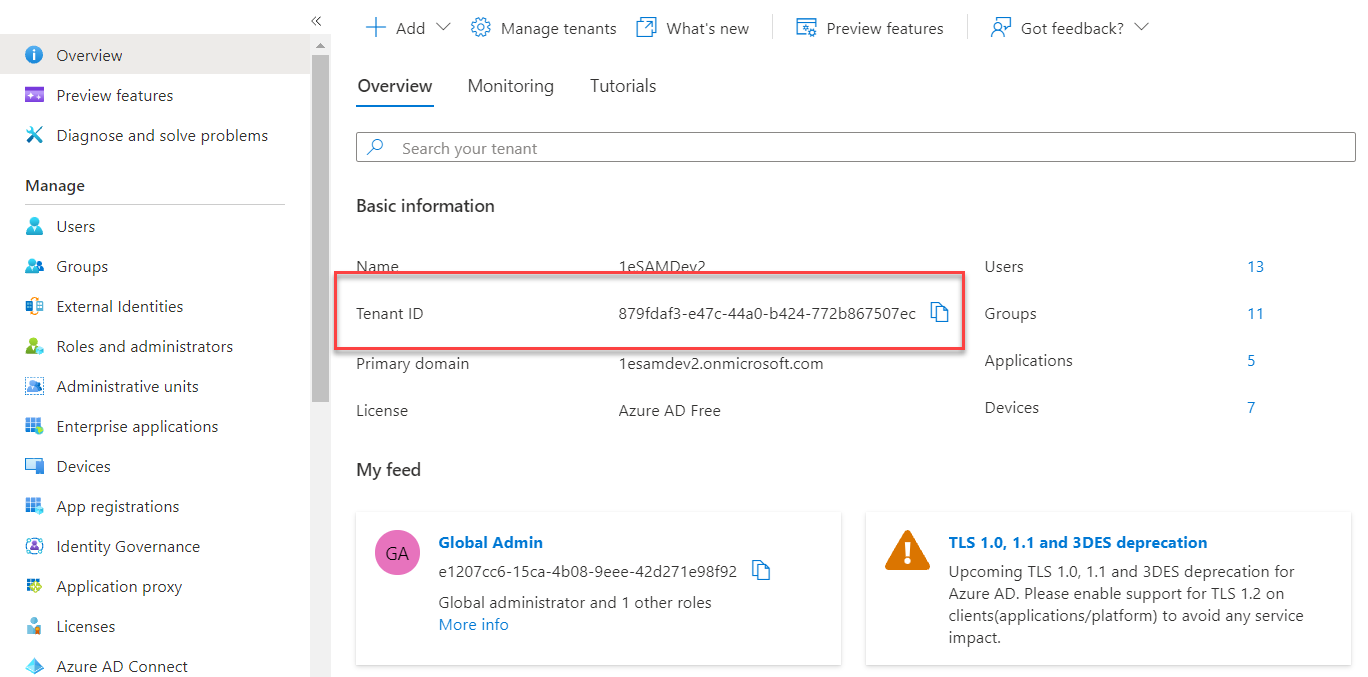
Enable PowerShell to connect to Azure using MSOL
On the Tachyon server where the Microsoft Office 365 connector will be executed, PowerShell needs to connect to Azure using MSOL, which requires the following two modules installed:
Install-Modules for Microsoft Office 365
Install-Module -Name AzureAD Install-Module -Name MsOnline
Note
If you see the following warnings when installing a module, you will need to run the following command first:
WARNING: Unable to download from URI 'https://go.microsoft.com/fwlink/?LinkID=627338&clcid=0x409' to ''.
WARNING: Unable to download the list of available providers. Check your internet connection.
[Net.ServicePointManager]::SecurityProtocol = [Net.SecurityProtocolType]::Tls12
Prepare an AAD application
In your Azure Active Directory console, go to the Enterprise applications node and click New application.

You need to create a non-gallery application, in the version of AAD we're using this is done by clicking the Create your own application button.
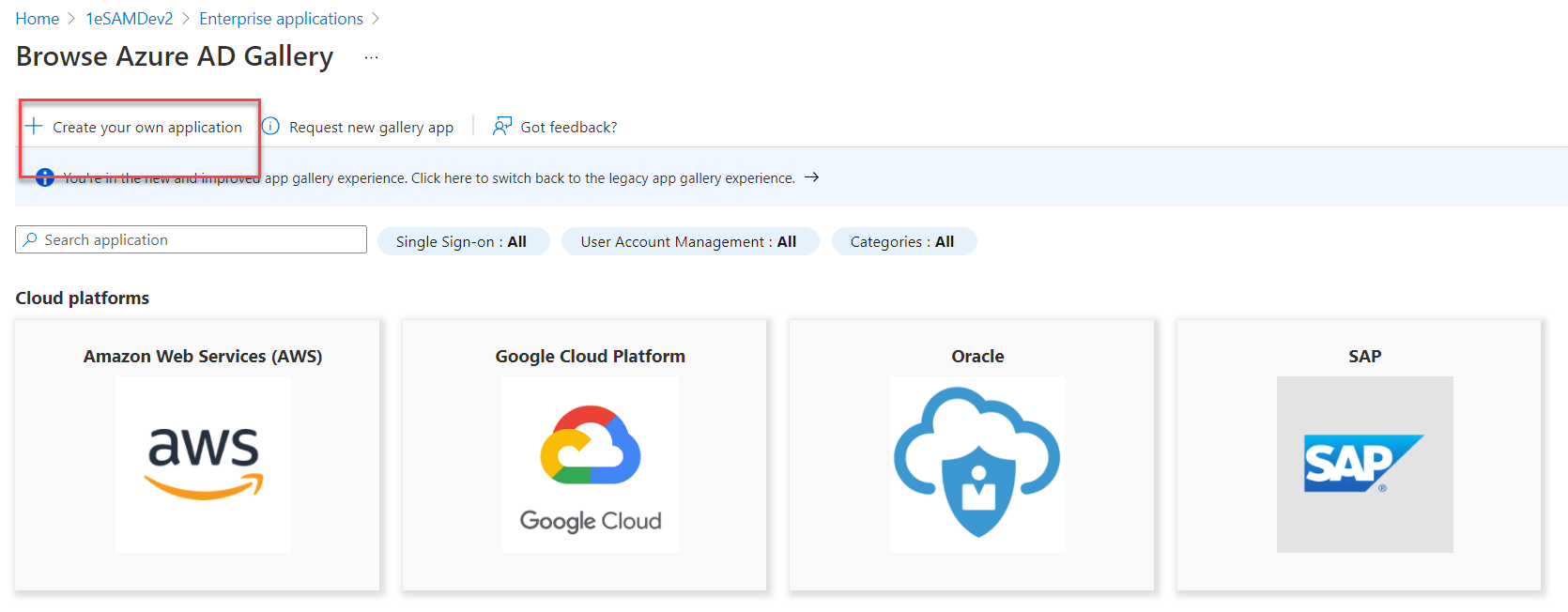
Provide a name for the application. The name of application should suggest the application is related to the Office 365 connector, for example: Tachyon O365 Connector. In this version of AAD we select the Integrate any other application you don't find in the gallery (Non-gallery) option and then clickCreatein the bottom left of the panel.

In the Overview tab for the new application, copy the Application ID value as this will be required for the connector.
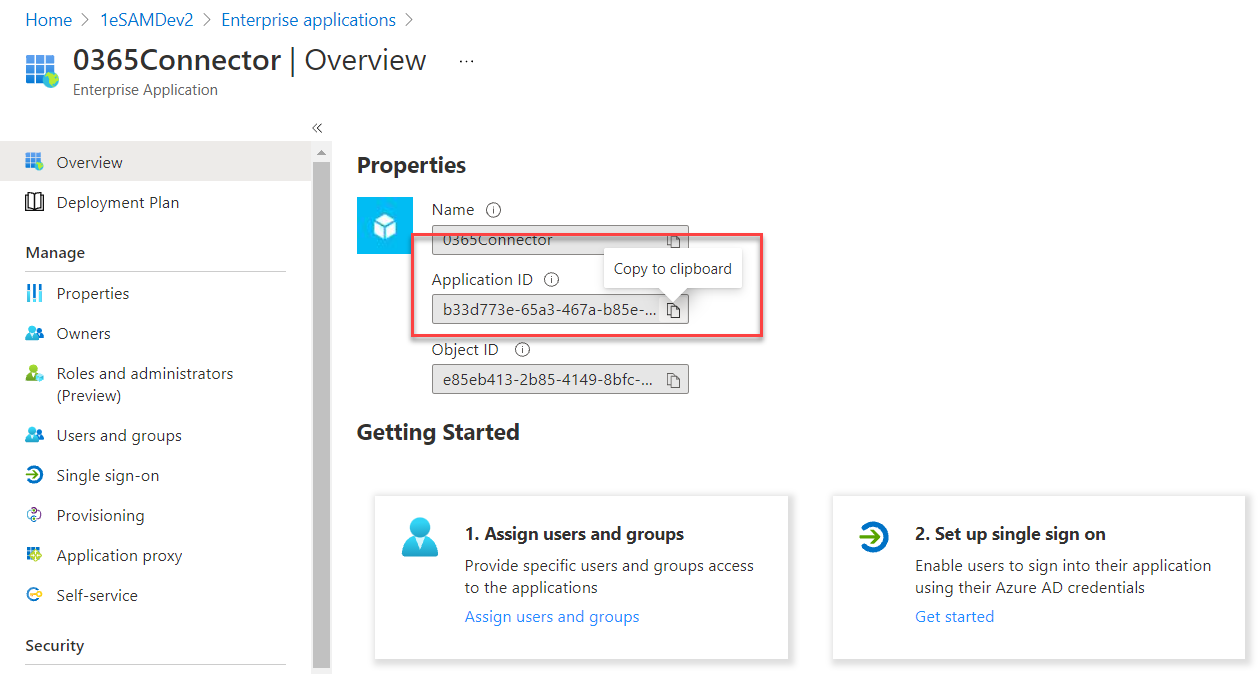
Navigate back to the AAD blade and click the App registrations node of AAD.
Note
You may need to change the tab to All applications to see the new application.
Click on the application name for the new application.
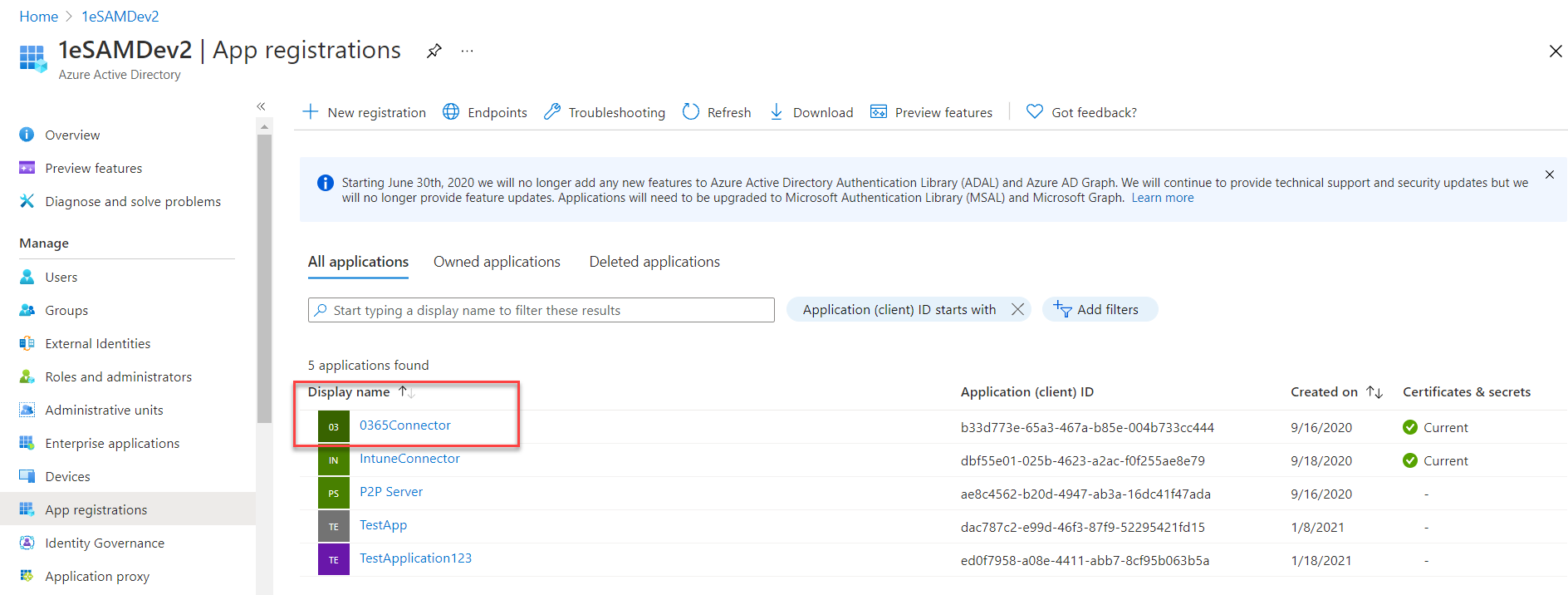
Add permissions
Click on the API permissions node under the Manage section, then click Add a permission.
Click on the Microsoft Graph tile and then click on Application permissions.
You will see a long list of API permissions, scroll through them and check as appropriate using the following table as a guide.
Group | Permission |
|---|---|
Device | Read.All |
DeviceManagementApps | Read.All |
DeviceManagementManagedDevices | Read.All |
Reports | Read.All |
User | Read.All |
When you have selected the correct permissions, click Add permissions. After they've been added, the permissions should like the picture shown opposite.
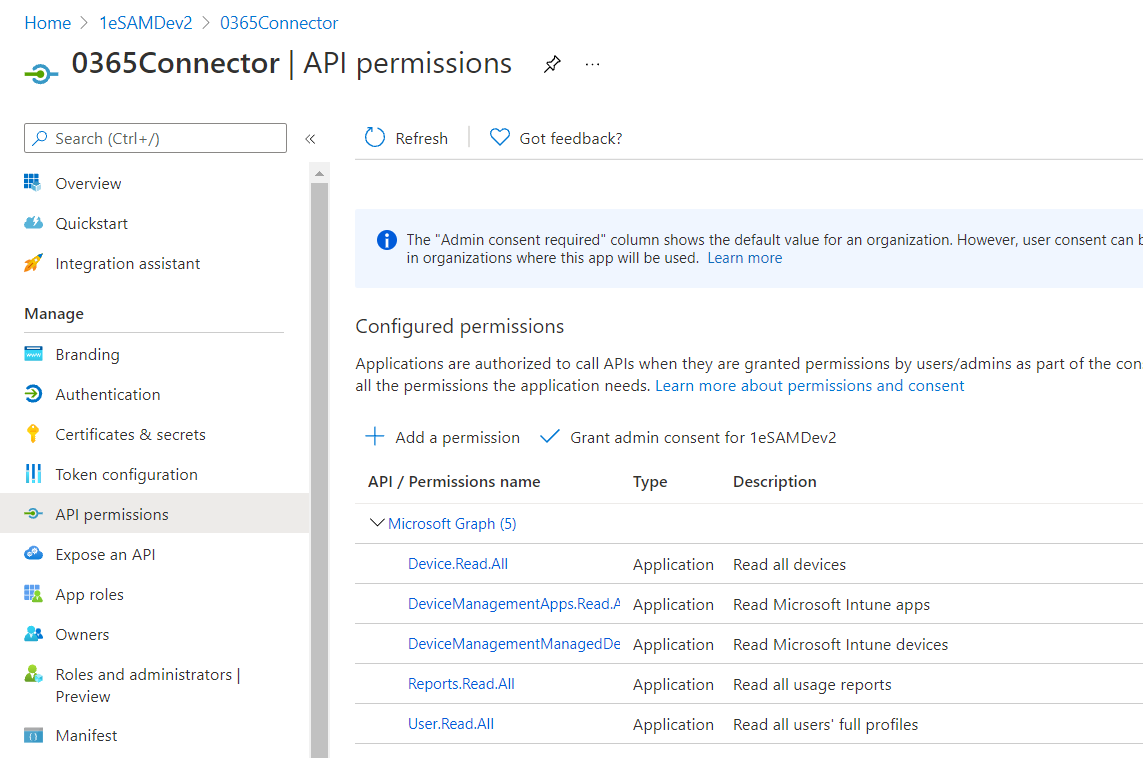
Click Grant admin consent for <organization>, where <organization> is the Organization you set when your InTune instance was created. This means that as an administrator for your organization, you're consenting that the users of the application can use these permissions. Click Yes to confirm.
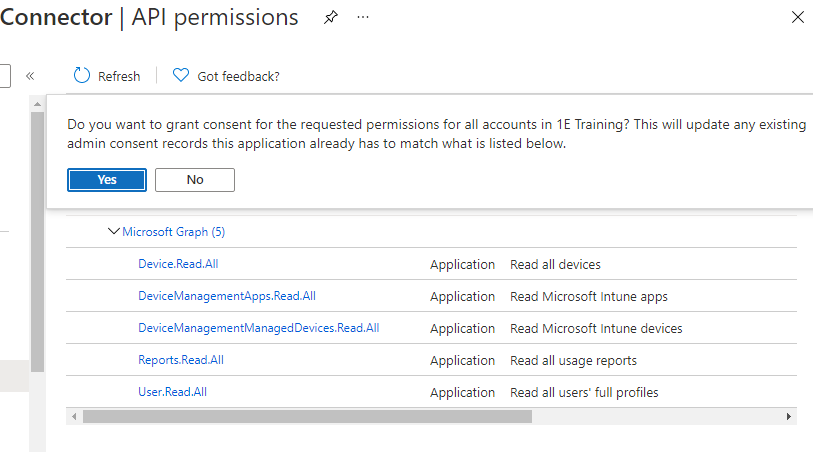
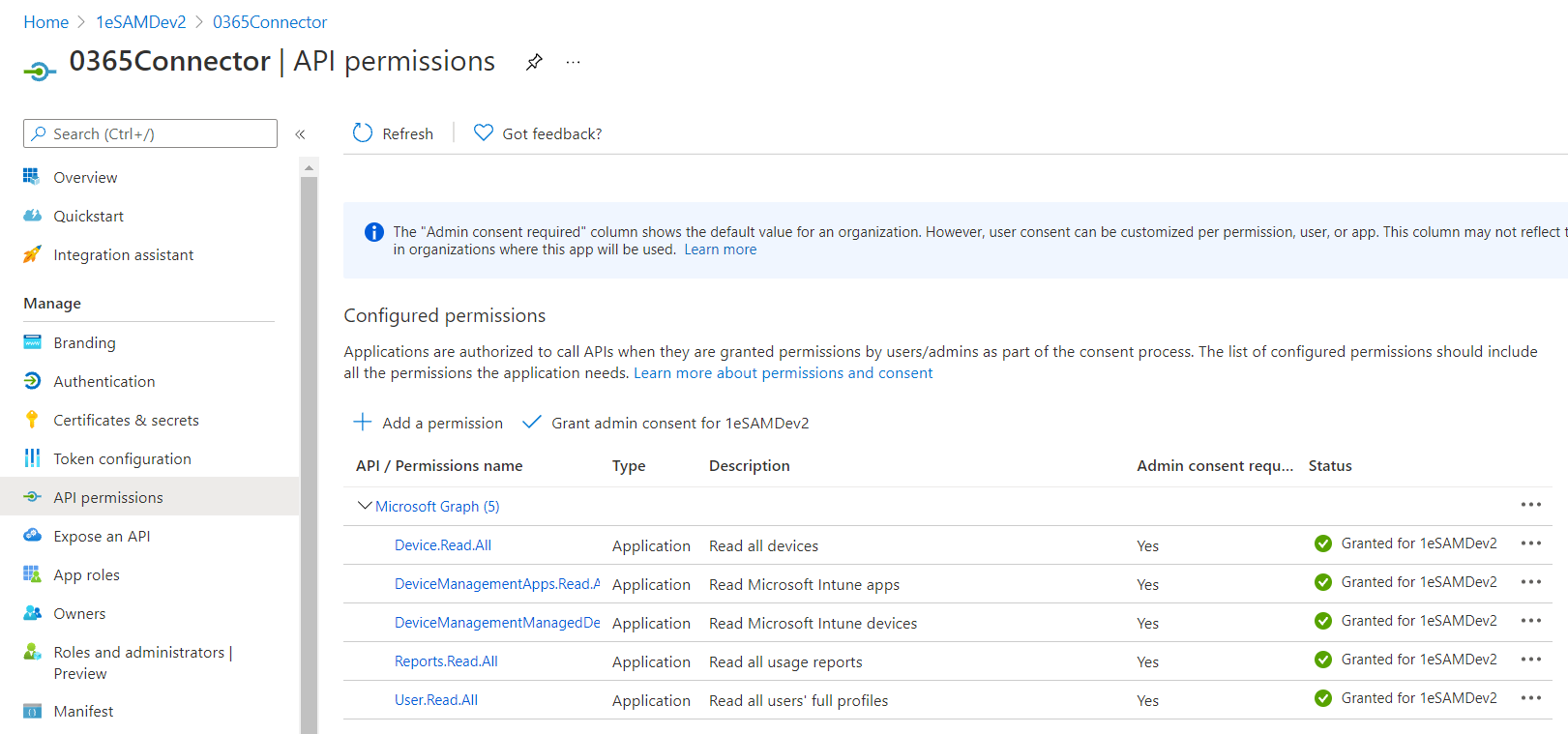
Add a client secret
Click on the Certificates & secretsnode, and then click on New client secret button
The Add a client secret form will open, add a description and select an expiry from the Expires options and then click Add.

Copy the new client secret Value and save it. It is important you save the client secret Value, as you won't be able to retrieve it after you perform another operation or leave this blade.
Warning
If you do not copy the Value at this point, when you navigate away from the Certificates & secrets screen you will be unable to copy it again. This means that you will have to delete the Secret and recreate it.
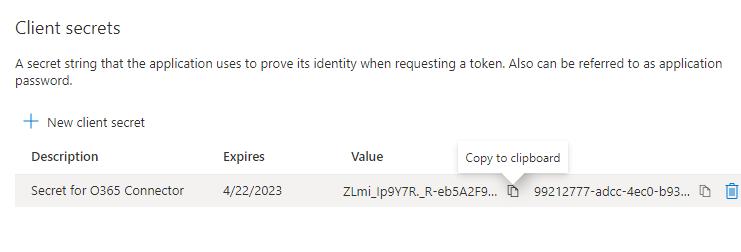
Add a user with the necessary permissions to run the PowerShell scripts
An AAD user with Reports Reader permissions must be made available in your organization's blade. The credentials for this user will be set in the Microsoft Office 365 connector when it is created in Tachyon.
Configuring the Microsoft Office 365 connector
These instructions show how to create a Microsoft Office 365 connector in the Settings application.
Adding, testing and running a Microsoft Office 365 connector
These are the steps to add, test and run a Microsoft Office 365 connector.
Adding a Microsoft Office 365 connector
In the Tachyon portal portal, navigate to Settings→Configuration→Connectors.
Click on the Add button.
In the Add connector popup select the Microsoft Office 365 type.
In Connector name, enter a logical name for this connector. In our example we choose the name Microsoft Office 365 Inventory.
Azure Cloud Instance can be set to the URL for your InTune implementation. If you leave this field blank AzurePublic is used as a default.
In Azure Tenant Id, enter your Azure tenant ID, available in the Overviewnode of your AAD console.
Client Id this should be set to your registered application clientID.
Client Secret this should be set to the specific client secret value created for your chosen Enterprise Application.
Login Email - set this to the permissioned user.
Login Password - set this to the password for the permissioned user.
Click Add.
The new connector has now been added and a new action to run the connector has been created in the background, called:
Sync Data - Microsoft Office 365 Inventory
Testing a Microsoft Office 365 connector
Select the Microsoft Office 365 connector by checking the box at the left-hand end of its entry in the Connectors table.
Click the Test button.
The Test status column for the connector will display a clock icon

indicating that the test has been queued for executing.
If the test succeeds Test status will display a check icon

, and the Last tested column will display the date and time the test succeeded.
If the test fails the Test status will display a failed icon

, and you'll need to check the details you entered for the connector.
If the test succeeds, you can proceed to run the connector to populate an inventory repository.
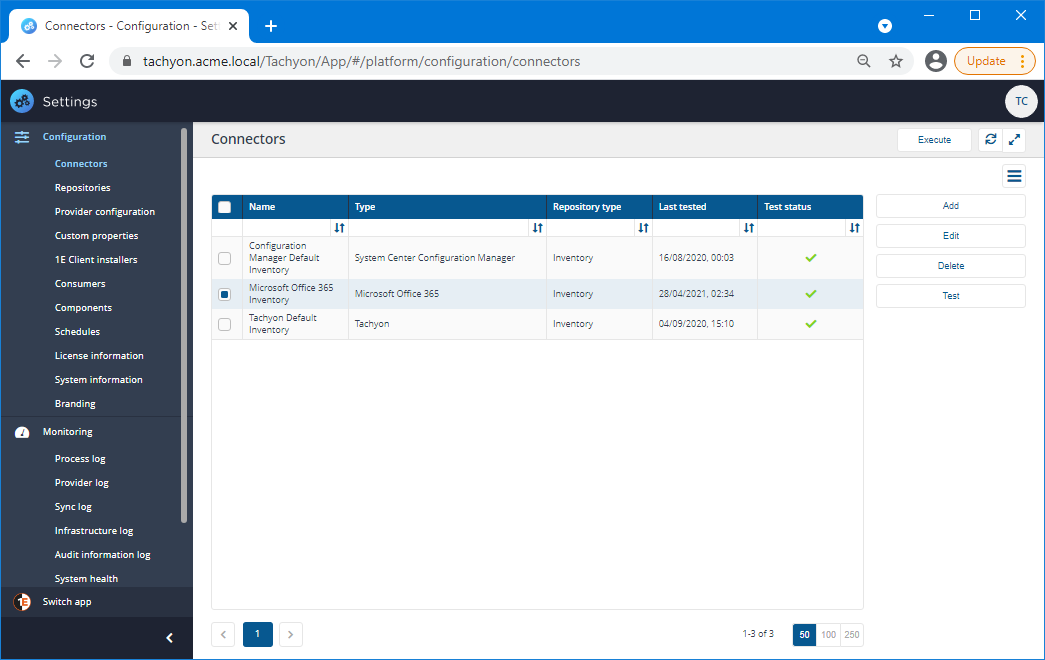
Running a Microsoft Office 365 connector
Click the Execute button.
In the Execute action popup subsequently displayed, use the Repository menu to select the inventory repository you want to populate.
Once the repository has been selected, you can then select the action to run. In the case of inventory repositories the actions will be restricted to inventory related actions. For a connector you will be looking for an action with the form Sync Data - <connector name>.
Select whether you want to clear any existing data in the repository by checking the Clean sync checkbox.
Click Execute button in the Execute action popup to start the sync.
When the sync starts, a number of actions are queued to be performed on the selected repository. To check the progress of the sync actions:
Navigate to the Monitoring→Process log page.
Here you can see the sequence of actions queued for the selected repository related to the Sync Data action selected.
When each action has finished running you'll see a check icon

appear in the Status column if it succeeds or a failed icon

if it fails.
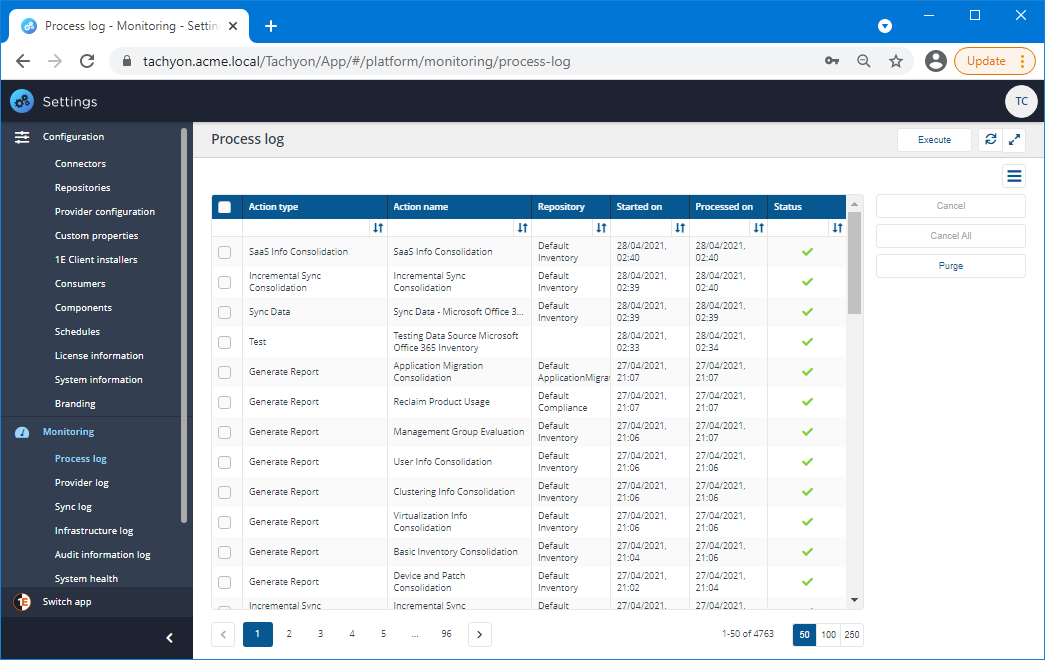
Viewing Microsoft Office 365 information in the Inventory application
Use the Switch app menu to open the Inventory application.
Navigate to Software Inventory→Product Usage page.
On this page you should see software items from your AAD environment.
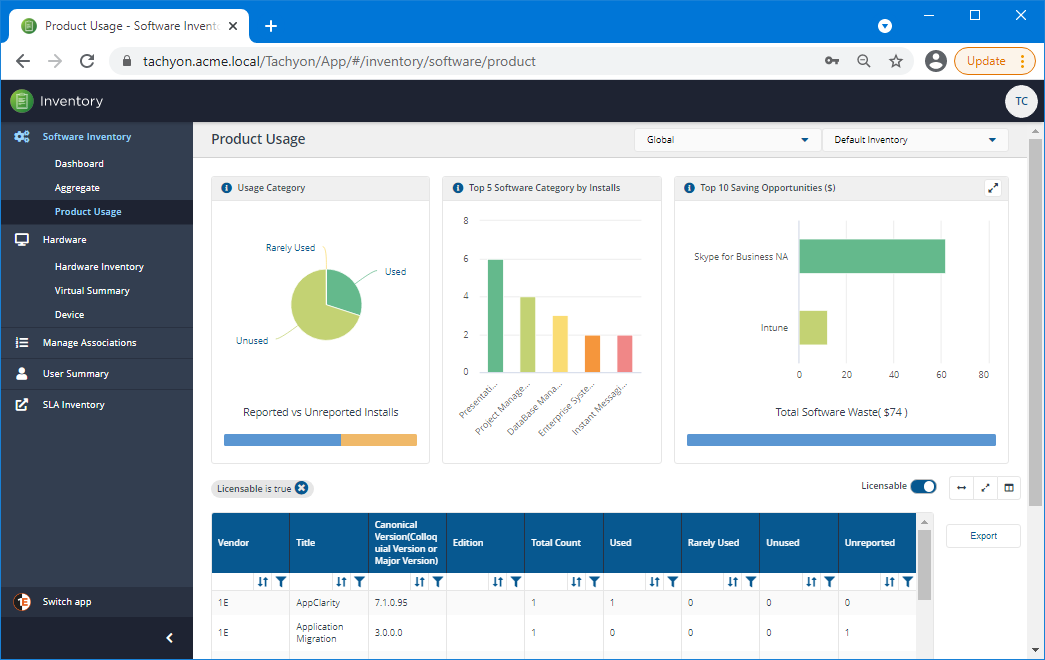
The Microsoft Office 365 connector parameters
The following fields are available in the Add connector and Edit connector popups when the Microsoft Office 365 Connector type is selected, as shown in the picture opposite:
Field | Description |
|---|---|
Connector type | Shows the connector type: Microsoft Office 365. |
Repository type | Shows which type of repository the connector works with. For the Microsoft Office 365 Connector type this is always Inventory. |
Connector name | Here you set the logical name for the connector. TipYou should use a naming convention for connector names: <connector type> <scope> <RCR> Scope describes where data is coming from or what it's being used for. For example Demo, Test, Lab, Q2 Audit. Include RCR in the name if you have enabled Run Consolidation Reports. |
Azure Cloud Instance | Azure cloud instance URL (optional) if this is not supplied, the AzurePublic is used as a default. |
Tenant Id | Azure tenant ID, available in the Overview node of your AAD console. |
Client Id | The registered application clientID. |
Client Secret | A client secret value that has been created for your chosen Enterprise Application. |
Login Email | The user login name for the permissioned user. |
Password | The password for the permissioned user. |
Run Consolidation Reports | Check the Run Consolidation Reports checkbox if you want consolidation actions to be processed each time the Sync Data action is executed for the connector. This can lead to unnecessary processing if you enable this on more than one connector. The recommended method of processing consolidation actions is to schedule the action Generate Report - Basic Inventory Consolidation to execute after the Sync Data actions have run for all connectors. This will execute the remaining consolidation actions. Alternatively check the Run Consolidation Reports checkbox on one of your connectors. You can view action processes in Settings→Process log. |
